Wagyu around the World - China
Origins of cattle and migration to China
A study of domestication in China is required to understand the origins of Wagyu in Japan because there is a common path for both.
Wild aurochs were present more than ten thousand years ago in different geographic areas but they have become extinct and present day China has a large cattle population with roughly one hundred million cattle from fifty three indigenous breeds (Chen et al., 2018).
Aurochs were the large and powerful predecessors of domestic cattle.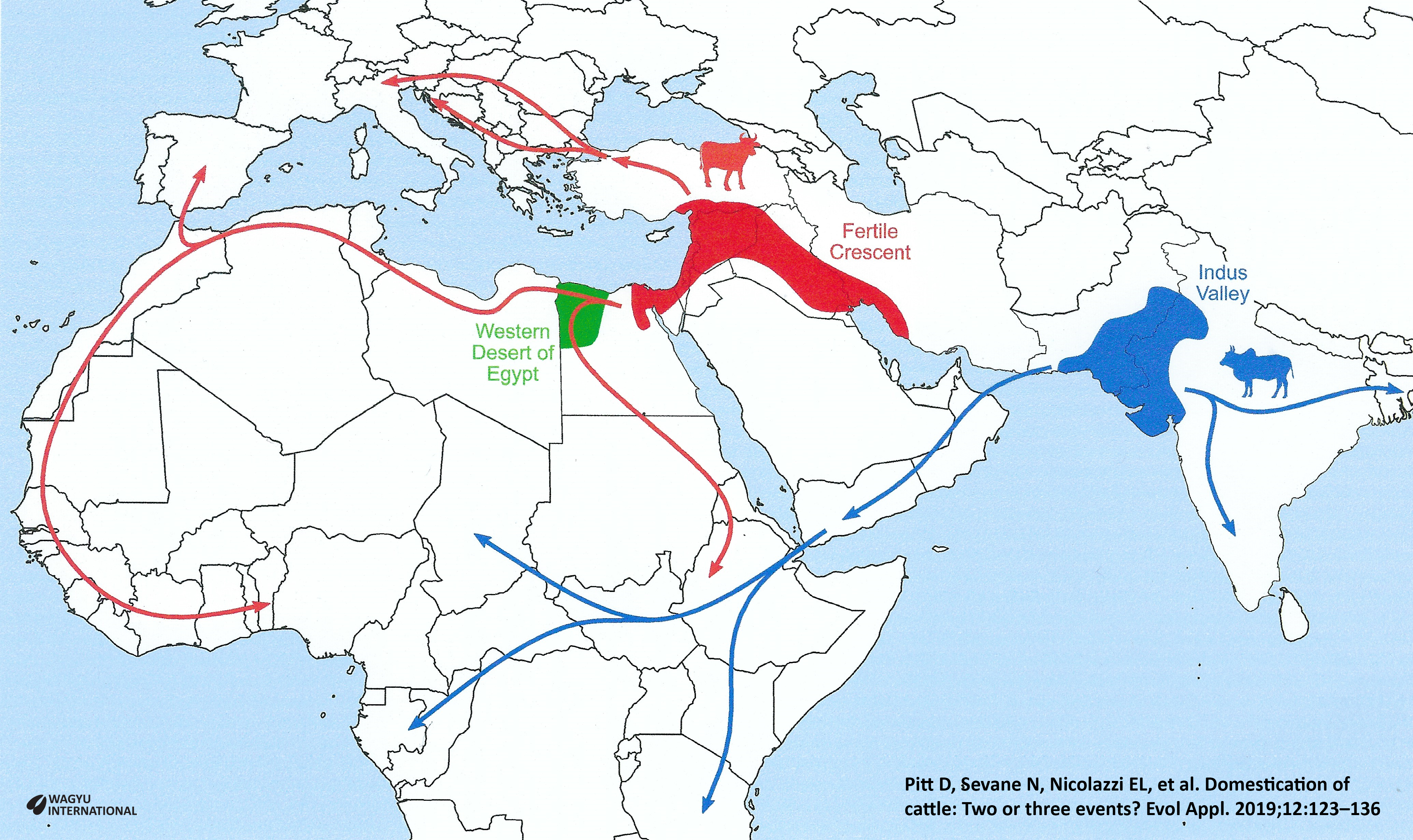 From the Bos primigenius genus they weighed between 300 and 800 kg, inhabiting a variety of habitats across Eurasia, but were gradually driven out by people who used their domesticated relatives to exploit their habitat.
From the Bos primigenius genus they weighed between 300 and 800 kg, inhabiting a variety of habitats across Eurasia, but were gradually driven out by people who used their domesticated relatives to exploit their habitat.
Taurine cattle (Bos taurus) were domesticated from Bos primigenius primigenius in the Fertile Crescent during the Neolithic, more than 10,000 years ago. They are illustrated in red colour on the map drawn by Pitt, Sevane and Nicolazzi et al., in 2019.
Approximately 1,500 years later a second domestication event took place in the Indus Valley from Bos primigenius nomadicus, separating from the taurine branch to give rise to indicine cattle (Bos indicus) which are also known as Zebu cattle. See the blue colour in the map above.
These are the two main domesticated lineages but a third domestication event has been hypothesized to have occurred in north-east Africa giving rise to the divergent African taurine cattle shown in green colour above.
Another event was the migration across Europe.
Domestication of cattle in China
There were differences in domestication across the different regions through Asia. The Yellow river people in China turned from hunting wild animals to the domestication of pigs, dogs, sheep and cattle during the Neolithic, the peoples of the Yangzi valley continued to rely on an abundant supply of wild creatures into their Bronze Age. Their staples were deer, fish and birds and there was a special relationship with fish that extended.
Archaeological evidence indicates that domesticated Eurasian taurine cattle were brought to China from Central and Western Asia during the Neolithic period 5,000 to 4,000 years before present, and were not domesticated from native East Asian aurochs populations. 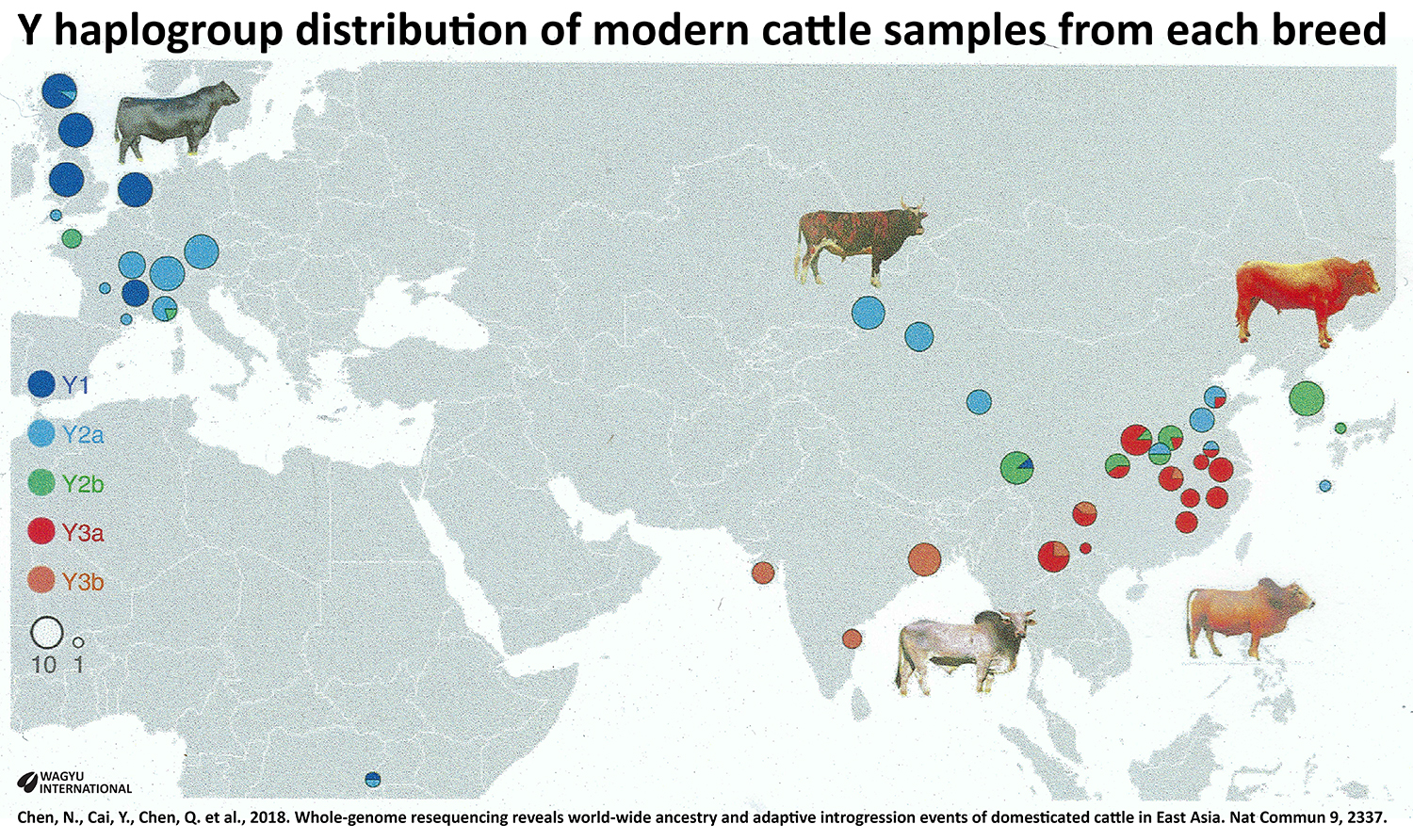 Later on, in a second migration, the East Asian taurine cattle became widespread over northern China and margins of the Tibetan Plateau during the expansion of millet agriculture about 3.6 thousand years ago.
Later on, in a second migration, the East Asian taurine cattle became widespread over northern China and margins of the Tibetan Plateau during the expansion of millet agriculture about 3.6 thousand years ago.
Indicine cattle (Bos indicus) may have dispersed from the Indian subcontinent to East Asia from 3,500 to 2,500 years before present. Chinese indicine cattle inherited around 2.93 % genome component from Banteng Bos javanicus ancestry at least 2.9 thousand years ago (Chen et al., 2018).
Archaeologists have often mistaken aurochs for domesticated cattle, and because wild aurochs could presumably have hybridized with domestic cattle, very little is known about the extinction of aurochs in China (Brian Lander and Katherine Brunson, 2018).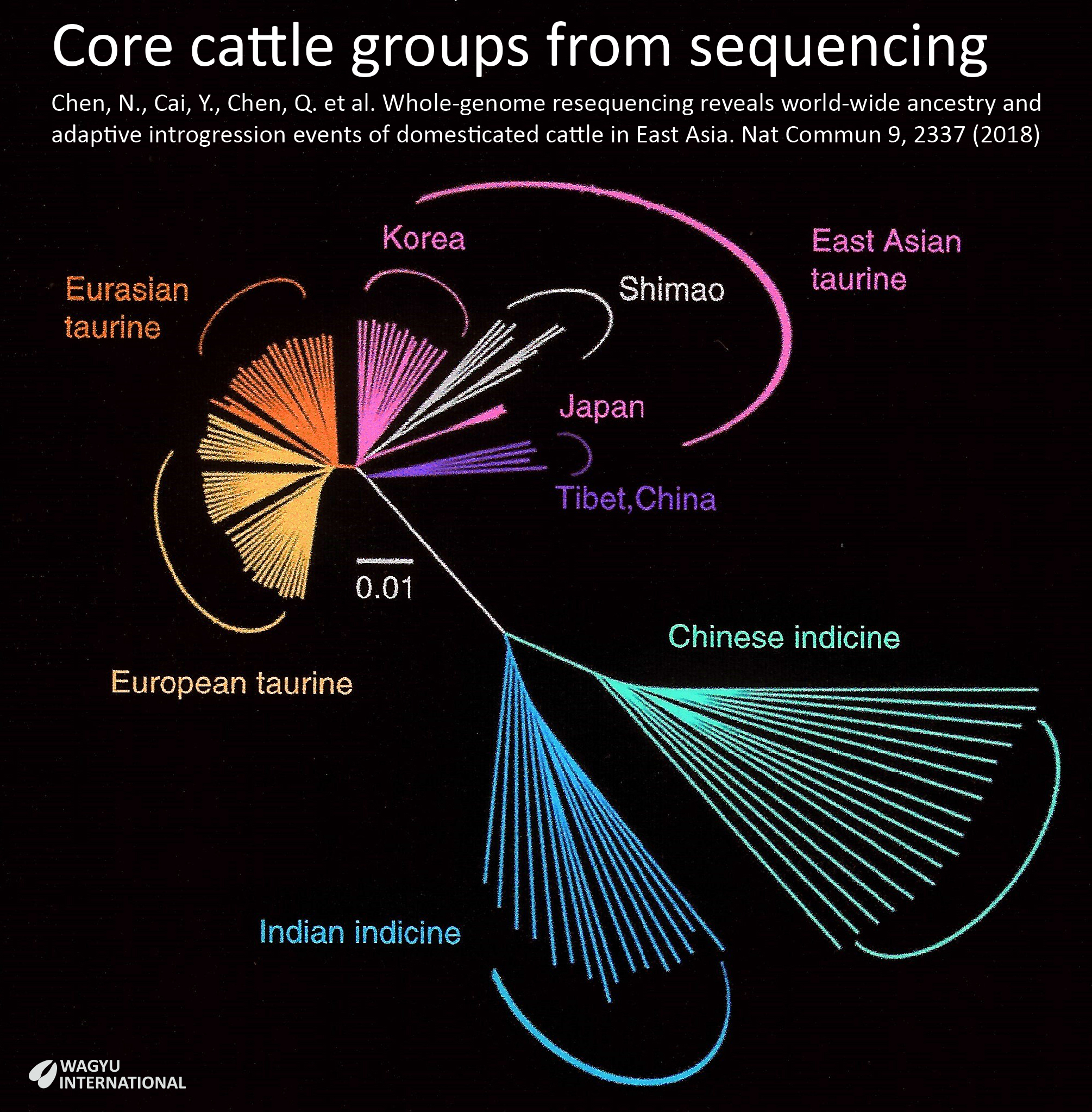
Archeologists located domestic taurine cattle (Bos taurus) in the upper, middle and lower reaches of the Yellow River regions of China about 4,500 years before present. However dogs were the first species to be domesticated in China. They were located in southern Hebei Province about 10,000 years before present. Pigs were the second species to be domesticated in southern Henan about 9,000 years before present. Domestic sheep followed cattle and appeared in Gansu-Qinghai region about 5,600 to 5,000 years before present. Domestic horses appear in eastern Gansu about 4,000–3,600 BP, and domestic chickens appear in north-eastern Henan about 3,300 BP. Each species originated or first appeared at different times and in different regions, but basically all of these species appeared in northern China first (Jing Yuan and Ningning Dong, 2019).
The earlier taurine strand may have migrated from north east China to Japan via the Korean peninsula at quite a late stage in the second century AD. 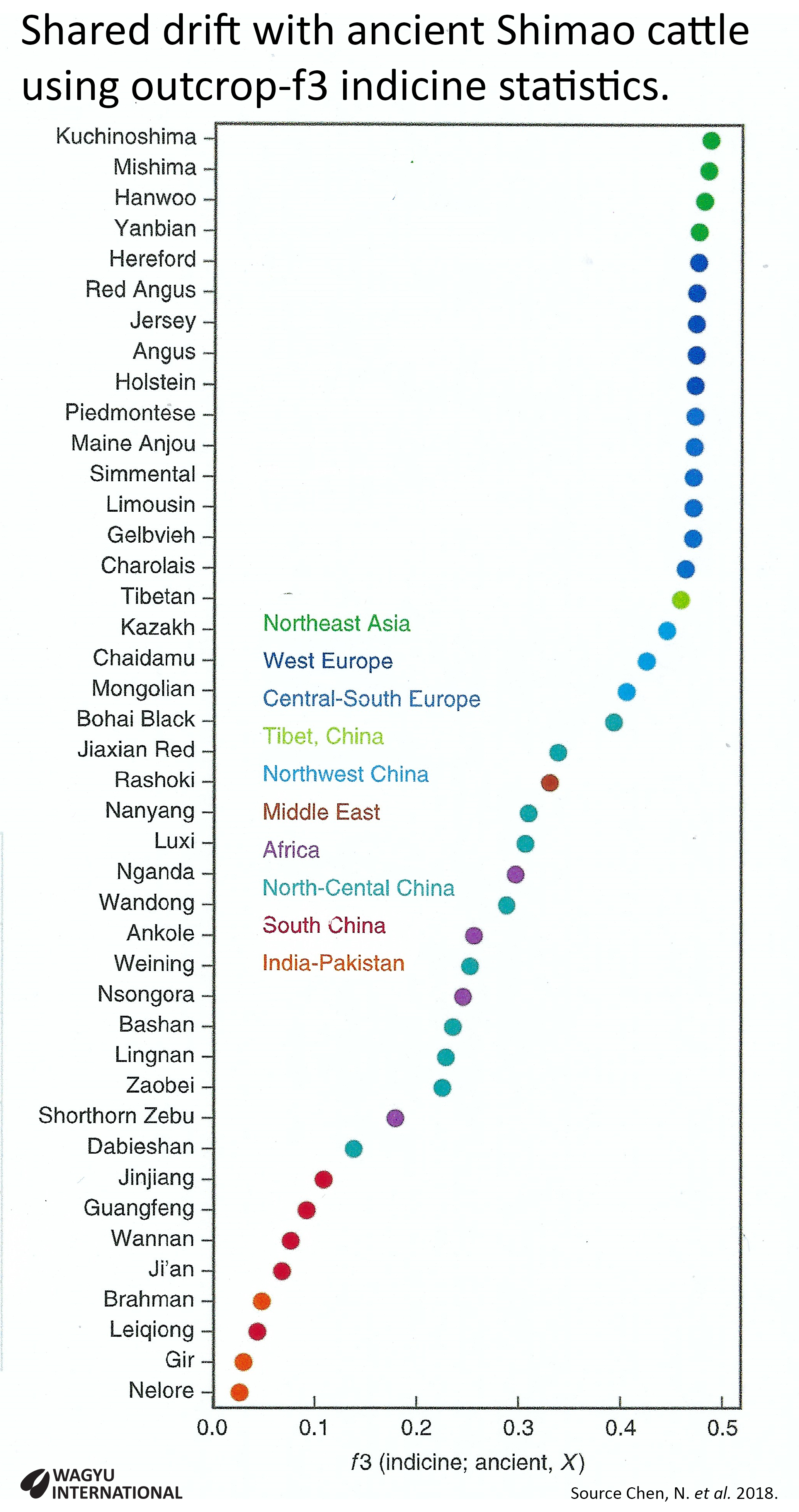 During sequencing of 48 modern breeds and eight East Asian ancient samples, the neighbour-joining tree revealed the closest affinity for Korean Hanwoo and native Japanese Mishima and Kuchinoshima cattle. (Chen et al., 2018). Hanwoo are genetically close to Yanbian cattle that are mainly found in North East China (Choi et al., 2016).
During sequencing of 48 modern breeds and eight East Asian ancient samples, the neighbour-joining tree revealed the closest affinity for Korean Hanwoo and native Japanese Mishima and Kuchinoshima cattle. (Chen et al., 2018). Hanwoo are genetically close to Yanbian cattle that are mainly found in North East China (Choi et al., 2016).
Haplogroup P is most common in European aurochs. It was unexpectedly identified in 45.9% Japanese Shorthorn together with T haplogroups 1 to 4 which are also found in Japanese Black, Japanese Brown and Japanese Polled breeds. It was considered that the Asian haplogroup P may originate from the ancient Asian population of aurochs because the native Japanese component of Japanese Shorthorn may have been introduced by the importation of cattle that accompanied horses from Siberia and Mongolia to north Japan between 1452 to 1454 (Noda et al., 2018).
To date, haplogroup P in modern cattle has been explained by rare events between female European aurochs and domesticated from the Near East. Chen et al., 2018, reported that haplogroup P was located in two Tibetan cattle and one Hanwoo animal from genome resequencing.
In recent developments, both Zhangmu and Apeijiaza cattle, two endangered breeds found in south west China's Xizang, have been cloned. There are only 19 Zhangmu cattle and 39 Apeijiaza cattle left, with only one available breeding bull.
Four male calves of each breed were recently born from surrogate mothers in Chongqing. Researchers collected the ear tissue, established a fibroblast cell line, and then used somatic cell nuclear transfer technology to prepare cloned embryos.
Half of the cloned bulls will be retained for semen collection after growing up while four will gradually acclimatize from lower altitudes to higher altitudes.
Wagyu production in China
'Wagyu Bio-Tech' was established in May 2008 for the breeding, production of beef and the sale of semen, 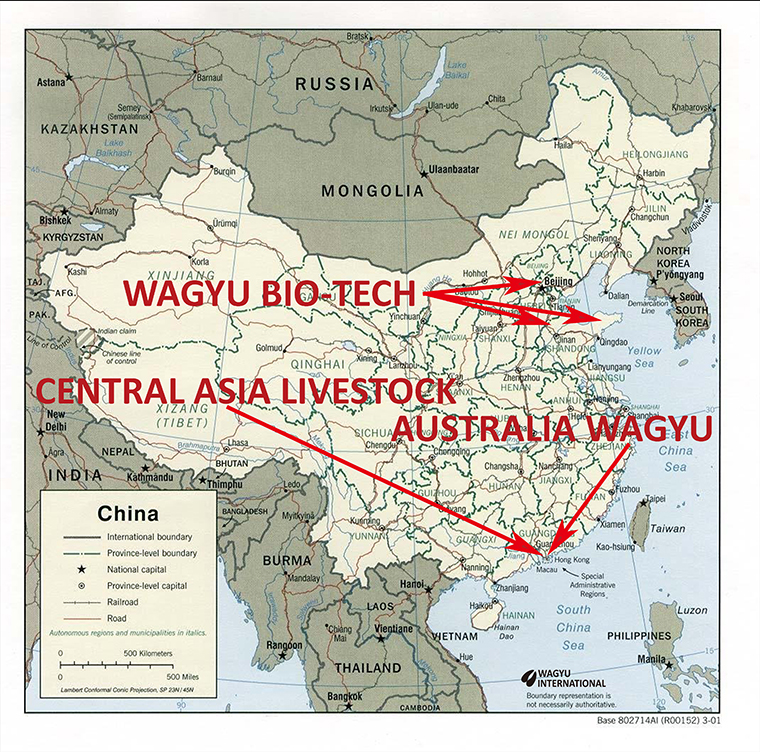 embryos and breeding animals. The key site is in Beijing Huairou District. Breeding takes place at another two properties at Chiping and at Laixi in Shandong District.
embryos and breeding animals. The key site is in Beijing Huairou District. Breeding takes place at another two properties at Chiping and at Laixi in Shandong District.
Wagyu Bio-Tech became members of the Australian Wagyu Association in 2011. This enabled the registration of progeny which were introduced from Australia as frozen embryos through Global Reproduction Services.
Rapid growth of numbers has taken place since 2012. The following year there were 1,200 pure Wagyu (of which 219 are registered with the Australian Wagyu Association as Fullbloods). 200 pure Wagyu were slaughtered. 200,000 doses of semen and 8,000 embryos were produced.
On 14th September 2013 collaboration was officially launched between Wagyu Bio-Tech and Beijing Animal Husbandry for technology and development in the "high quality beef" industry.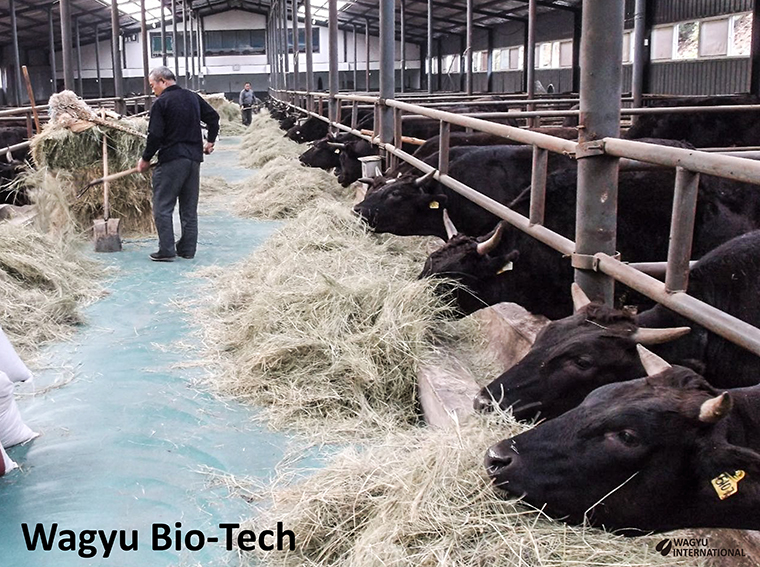
Sven Fu has been involved in Wagyu industry since 2012 and offers semen, embryos and beef through 'Australia Wagyu' and has 99 registered Wagyu in Australia and facilities in Hong Kong.
Grassland Wagyu Investment Co., Ltd., was established in 2011. The operation includes dairy, Wagyu, other livestock and poultry production.
Tianjin Boyu Limu Technology Co., Ltd. is headquartered in China Tianjin Shi and was founded in 2016.
References
Australia Wagyu.
Chen Qingqing, Chen, 2024. Update: World’s first cloned endangered Xizang cattle species born. Global Times, 29 January 2024.
Schwartz, Dominique, ABC News, 2017. Gina Rinehart launches wagyu brand bound for China's top restaurants. 7 February 2017.
